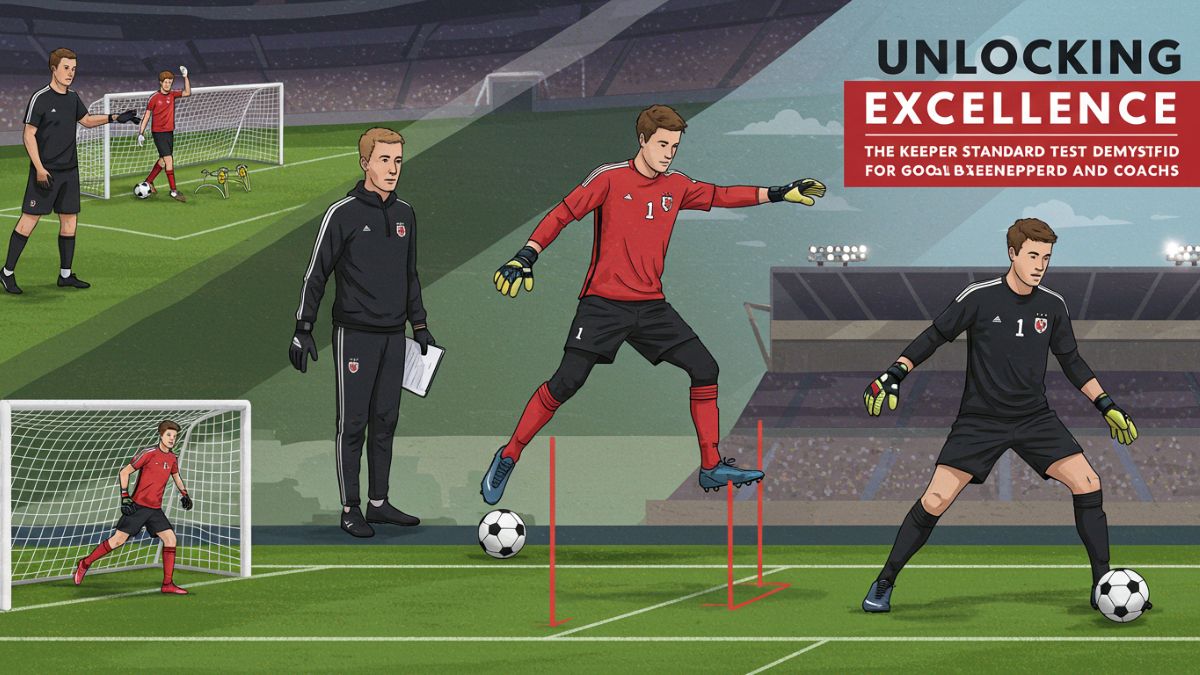SPORTS
Unlocking Excellence: keeper standard test Demystified for Goalkeepers and Coaches

In the rapidly evolving realm of football, goalkeepers cannot rely solely on instinct and raw talent. Today’s elite keepers use data-driven evaluations like the Keeper Standard Test to pinpoint strengths and weaknesses. From reaction drills to distribution metrics, this assessment offers a holistic snapshot of a goalkeeper’s abilities. In this article, you will discover exactly what the Keeper Standard Test measures, why it matters, and how to leverage its insights for continuous improvement.
What Is the Keeper Standard Test?
The keeper standard test is a specialized comparative assessment designed to quantify key goalkeeping skills under standardized conditions. Unlike subjective scouting reports, this battery of tests applies consistent parameters—such as shot speed, drill duration, and distribution targets—so that performances can be accurately benchmarked against peer groups or elite norms.
Key features of the Keeper Standard Test include:
-
Objective Scoring: Each task awards points based on predetermined criteria.
-
Modular Design: Components cover shot-stopping, handling, footwork, decision-making, and communication.
-
Repeatability: The test can be administered periodically to chart progress over weeks, months, or seasons.
Core Components of the Keeper Standard Test
1. Shot-Stopping Efficiency
At the heart of the keeper standard test lies a series of shots delivered at various angles, heights, and velocities. Goalkeepers face volleys from short-range (8–12 yards) and long-range (20+ yards), with speeds calibrated between 40 and 70 mph. Scoring hinges on clean saves, control of rebounds, and swift recovery—each element weighted to reflect real-game priorities.
2. Handling and Rebound Management
Secure handling under pressure is critical. In this module, goalkeepers catch or parry shots with nets positioned to simulate congested penalty-area scenarios. Points are awarded for:
-
Clean Catches: Removing the ball from play.
-
Controlled Deflections: Directing rebounds away from danger zones.
-
Recovery Speed: Regaining readiness within three seconds.
3. Agility and Footwork
Elite goalkeepers must cover the goalmouth swiftly. The keeper standard test uses ladder drills, lateral shuffle courses, and hurdle sequences to assess acceleration, balance, and change of direction. Times are recorded to the hundredth of a second, providing granular insight into a keeper’s mobility.
4. Distribution Accuracy
Modern football demands that keepers initiate attacks. This section evaluates:
-
Throwing Distance & Precision: Hurling accurate balls to specific targets at 15–25 meters.
-
Kicking Under Pressure: Delivering driven passes past defenders while sensing simulated opposition closing in.
-
Roll-Outs and Ground Passes: Maintaining possession in tight spaces.
5. Tactical Decision-Making
Simulation drills place a goalkeeper in dynamic, game-like situations—such as cross-delivery scrums or one-on-one breakaways. Judges score each decision on criteria like positioning, timing of exit from the goal line, and risk assessment when distributing.
6. Communication & Leadership
Communication is often the “silent skill” that separates good keepers from great ones. In the Keeper Standard Test’s, candidates organize defensive walls or direct a shifting back line during set-piece simulations. Assessors rate tone, clarity, and proactive instruction.
Why the Keeper Standard Test Matters
Benchmarking Performance
By quantifying skills, the Keeper Standard Test eliminates guesswork. Players receive a clear report card showing how they stack up against age-group or professional benchmarks.
Personalized Training Roadmaps
Rather than generic goalkeeper drills, coaches can tailor sessions to address specific deficiencies—whether that means extra plyometric work for agility or shooting drills to refine rebound control.
Talent Identification
Scouts and academy directors use Keeper Standard Test’s scores to compare prospects on a level playing field. Consistent testing protocols ensure fair evaluations across different regions and training environments.
Motivation and Accountability
Data-driven feedback motivates keepers to set tangible goals. Tracking improvements—from shaving tenths off agility times to boosting throwing accuracy—keeps training focused and rewarding.
Preparing for the Keeper Standard Test
1. Build a Holistic Fitness Regimen
Goalkeepers must blend strength, speed, and endurance. Incorporate compound lifts (squats, deadlifts), plyometric drills (box jumps, lateral bounds), and HIIT circuits. A well-rounded gym plan lays the groundwork for outstanding on-field performance.
2. Drill Under Varied Conditions
Recreate test scenarios at different times of day, weather conditions, and ball types. Practicing shot-stopping in low light or handling slippery balls ensures adaptability during the actual Keeper Standard Test.
3. Enhance Cognitive Readiness
Mental resilience is crucial when pressure mounts. Use visualization exercises, decision-making drills with numbered lights, or VR simulations (if available) to sharpen focus and situational awareness.
4. Seek Constructive Feedback
Have coaches video-record trial runs of the keeper standard test’s drills. Reviewing footage frame by frame reveals subtle technical flaws—such as foot placement during spreads or the angle of the catching hand.
Common Pitfalls & How to Avoid Them
| Pitfall | Solution |
|---|---|
| Overemphasis on One Skill | Balance training across all test components. |
| Neglecting Recovery & Rest | Schedule deload weeks and prioritize sleep for regeneration. |
| Inconsistent Warm-Ups | Develop a repeatable pre-test routine to prime the body. |
| Ignoring Nutrition | Fuel workouts and recovery with balanced macronutrients. |
Interpreting Keeper Standard Test Results
After completing the Keeper Standard Test, results are typically presented as:
-
Raw Scores: Numeric values per drill (e.g., catch percentage, agility time).
-
Percentile Ranks: Comparison against peer groups (e.g., top 10% for distribution).
-
Composite Index: Overall rating combining all modules into a single “Keeper Score.”
Use these metrics to inform season-long goals, such as progressing from the 30th to the 60th percentile in handling over three months.
The Future of Goalkeeper Assessment
Advancements in GPS tracking, wearable sensors, and machine-learning algorithms are expanding the scope of the Keeper Standard Test. Soon, metrics like body-load stress, reaction-path efficiency, and even gaze-tracking during saves may become standard. By staying abreast of these innovations, coaches and keepers can maintain a competitive edge.
Conclusion
The Keeper Standard Test represents a new paradigm in goalkeeper evaluation—one rooted in objective data, repeatable protocols, and actionable insights. Whether you’re a rising talent in an academy, a seasoned pro looking to extend your career, or a coach dedicated to maximizing your squad’s potential, this test offers a roadmap to excellence. Embrace the Keeper Standard Test, integrate its findings into your training, and watch your goalkeeping prowess reach new heights.

-

 Technology5 months ago
Technology5 months agoExploring Cinnego: The Future of Digital Connectivity
-
Blog6 months ago
Learn All About The Popular Australian Labradoodle!
-

 General6 months ago
General6 months agoBaddieshub.com: Everything You Need to Know About This Controversial Website
-

 Blog6 months ago
Blog6 months agoHow To Reduce Dust In House With Dogs
-

 General5 months ago
General5 months agoUncuymaza: Weaving the Threads of Andean Heritage
-

 General5 months ago
General5 months agoUnveiling jonathonspire: The Journey of a Creative Mind
-

 Health6 months ago
Health6 months agoHygropack: Revolutionizing Moisture Control for Sustainable Product Preservation
-

 Digital Marketing6 months ago
Digital Marketing6 months agoraterpoint: Revolutionizing Feedback and Performance Evaluation